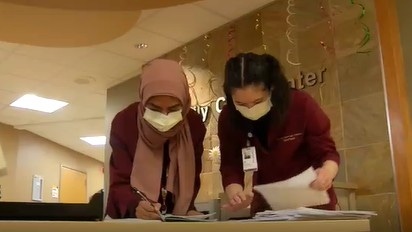Hospital program allows teen volunteers to lend a helping hand
[anvplayer video=”5097045″ station=”998122″]
“Hey do you know anything about twenty-six?” asked Sadio Aar on her smart badge device. “I know they told you about her heart rate earlier, right?”
Aar, a charge nurse for general surgery at M Health Fairview Southdale Hospital, organizes care for up to ten patients a day.
And time is precious.
“Sounds like seconds count?’ we asked. “Yes, for sure,” Aar smiled.
Turns out, the medical staff here has a unique backup, called the Junior Volunteer program.
“When you come in here you like see the spectrum of jobs that everyone is doing,” says Sarah Malik, an 18-year-old volunteer. “And it really opened my eyes to see how the mission of a hospital is not just on the doctors’ or the nurses’ shoulders, but it’s everybody working together for one mission.”
“Anything we can pick up to ease the burden, that’s what they do,” adds volunteer coordinator Nancy Schaber. “Discharging patients, taking blood samples to the lab, picking up charts, that sort of thing.”
Forty-one area students, aged 15 to 18, hit the hallways, delivering charts, prescriptions and lab samples.

It’s named STEP Force — short for Speedy Transport and Escort Personnel.
“The program started when the hospital opened,” Schaber notes. “They were candy stripers and they delivered flowers.”
Fast forward to present day: yes, they do deliver flowers.
But perhaps their most important duty is saving time for the medical staff.
“It’s really helpful to be able to call them and say, hey, I need this blood product right away, please bring it up to me,” Aar says.
An M Health Fairview spokesperson says through the pandemic and the staffing shortage here, the program allows medical staff to stay at their stations and save valuable time with every run a junior volunteer makes.
“So I’m saving about ten to fifteen minutes, you know,” Aar says. “That really helps me focus on my patients and provide other care that I need to provide, so I think it really helps with the burnout.”
Southdale isn’t releasing specific figures, but says its staffing numbers have fallen.
The Minnesota Department of Health says statewide, hospital jobs have dropped from 118,000 in March of 2020, to 110,000 during the shutdown, then back up to 112,000 by the end of 2021.
“I think it’s supercool,” exclaims Isadora Li, a 17-year-old volunteer from Edina. “Especially with the pandemic and how busy things have been, and how chaotic. It feels nice that I can help out in a little bit.”
Southdale emphasizes these students are not medical personnel — but they are making a difference.
They also have other duties like sanitizing equipment and making beds.
“When you see like the relief on people’s faces, helping them out, or like the happiness of patients, when you give them flowers, it’s so uplifting,” Malik says.
The volunteers have one shift a week, three hours on weekdays, and four hours on weekends.
Southdale says it’s planning to expand the program to sixty volunteers during the summer.
Along the way, the students get first-hand experience.
That includes University of Minnesota medical student Brooke Hendricks, who took part in the program in 2009.
“I was kind of interested in medicine starting in elementary school,” she says. “Definitely just being in a hospital, being comfortable around patients and providers, definitely affirmed to me that medicine was where I wanted to end up.”
Hendricks says she learned Friday that she’s starting her residency with Hennepin Healthcare, at HCMC.
Both Li and Malik says they’re keenly interested in pursuing a career in medicine.
Meanwhile — they’re walking between 1,500 and 3,000 steps per shift.
“Lot of steps, yeah,” Li says with a grin. “Typically every run is at least down and up a few elevators and across like a few floors, I’d say.”
Schaber says with every step, she’s proud of her teen volunteers.
“It’s just a beautiful thing to see, all these different types of kids, who don’t know each other and they all come together and they service the hospital,” she says. “It’s very gratifying to see them and how they grow.”